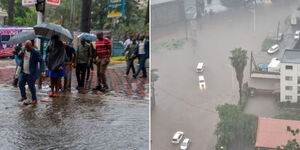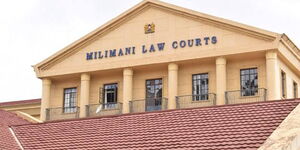If the biblical book of Lamentations were still up for updates, Kenyan farmers would easily fill up one long chapter.
The story of a Kenyan farmer is one of hard labour, long and tedious days toiling and sweating in the exceedingly barren land, with little or no returns to show after a whole year of slaving on the farm.
As I write this piece, the Cabinet Secretary for Agriculture, Peter Munya, has announced a raft of measures including importing maize from neighbouring countries to settle the pang of hunger raving many stomachs in the country.
Munya has also suggested that Kenyans stop overreliance on their favourite meal, ugali and try other foods. He fell short of advising Kenyans with the Njeru Githae’s 'you can eat rats' quote.
To sweeten the deal for the middlemen who seem to be the main beneficiaries of maize shortage in the country, the CS speaking at the Namanga border on Tuesday, June 28 said the government will gazette a directive that will suspend the levies imposed on imported maize.
The move, Munya insisted, would lower the cost of flour that is now retailing at Ksh210 for a two-kilo packet.
In late April 2022, a month after farmers had already sowed their seeds using expensive fertilizer that was then going for Ksh6,000 a bag of 50 kilograms, the same minister announced that the price of the popular DAP fertilizer had been reduced to Ksh2,800.
By then, most farmers had already planted their maize with little or no fertilizer or abandoned the loss-making venture altogether. I was one of those who abandoned the venture.
Munya’s “short-lived” goodies, a month before the elections, aren’t news. The same interventions were read two months before elections in 2017 when Jubillee was seeking a second term.
The then Agriculture Cabinet Secretary Willy Bett announced an Ksh6 billion maize subsidy to lower the cost of flour to Ksh90.
The 2013 Jubilee manifesto was big in promises to revamp agriculture: “…increase efficiency in agricultural production through mechanization and employment of modern technology in farming while enhancing the certified seed and fertilizer subsidy programme to reduce the cost of food production and manage inflation.”
Ten years later, I am one of those farmers who would fill up the first chapter of the new book of Lamentations. For years, I have been a maize farmer and I have over the years grown different varieties of crops hoping to join the millionaires club in vain.
When growing up on the slopes of Cherangany Hills, at the heart of Kenya’s breadbasket in Trans Nzoia County, milk and honey were literally flowing down the slopes. Then, the cooperative society movement was a powerhouse that helped farmers grow their wealth season after season.
My grandmother never had to crack her head looking for buyers for her milk, two different cooperative society trucks would come to pick up the milk a few metres from home without fail.
At the end of the month, my grandmother would take the "face me" matatu to Kitale town where she would find her money waiting at her Posta account. Growing maize was stress-free with low fertilizer prices and assured market at National Cereals and Produce Board.
Farming then was that simple.
Over the years, the government deliberately killed the cooperative movement, the Kenya Farmers’ Association (KFA), a bank that gave farmers loans to expand their enterprise was killed through a coordinated looting spree by those in power. By the end of it, farmers were left poorer and without capital.
And then followed successive post-election violence that disrupted the farmers' base. Cattle were raided and maize acreage continued to shrink over the years due to unreliable rain cycles, expensive inputs, and lack of storage which lead to farmers selling their maize at a throwaway price to middlemen immediately after harvest.
My grandmother who used to farm maize on over 15 acres of land progressively cut her acreage to two acres in 2021. This means that from the production of around 450 bags of maize she now hardly produces over 30 bags in a good year.
Today, her biggest challenge is that when she grows more acreage and the harvest is high the government creates an artificial shortage and imports maize leaving the farmer with dead stock that she can't sell nor store. Such continuous battering of farmers has led to diminished output leading to food insecurity.
Land fragmentation has been a great impediment to maize farming. My grandmother had 25 acres of land which was subdivided among her eight children.
This in essence meant that each child hived off half an acre for homestead and instantly became subsistence farmers. Growing maize below 20 acres is a loss-making venture according to experts.
“Farmers with less than 20 acres of land should not grow maize for commercial purposes since this is not profitable,” Agriculture Principal Secretary Hamadi Boga was quoted saying by Daily Nation.
The challenge facing farmers is more complex than giving temporary subsidies in an election year; they lack cheap and quality seeds, access to capital, low output, unpredictable weather, high taxation and non-existent extension services.
Many years ago we used to get an extension officer every week, he had a motorcycle to ease his movement. Today such services are a luxury to my grandmother.
I stopped growing maize this year because of the big losses I made last year. After spending a fortune to grow the maize, at harvest time Maize was being bought by middlemen at between Ksh1,900 to Ksh2,100.
Today the same bag of maize is selling at over Ksh5,000 a bag of 90kgs. The sad reality most farmers cannot dry and store maize until such a time when the prices are high.
My grandmother who in the 80s was seen as a rich farmer cannot afford to buy a bag of maize to feed herself today. Most farmers are poor, living in squalor as politicians keep lighting up their manifestos with fake promises in reviving agriculture.












